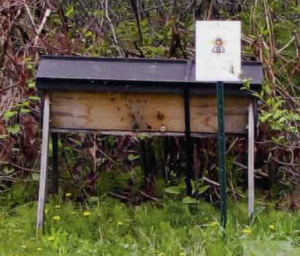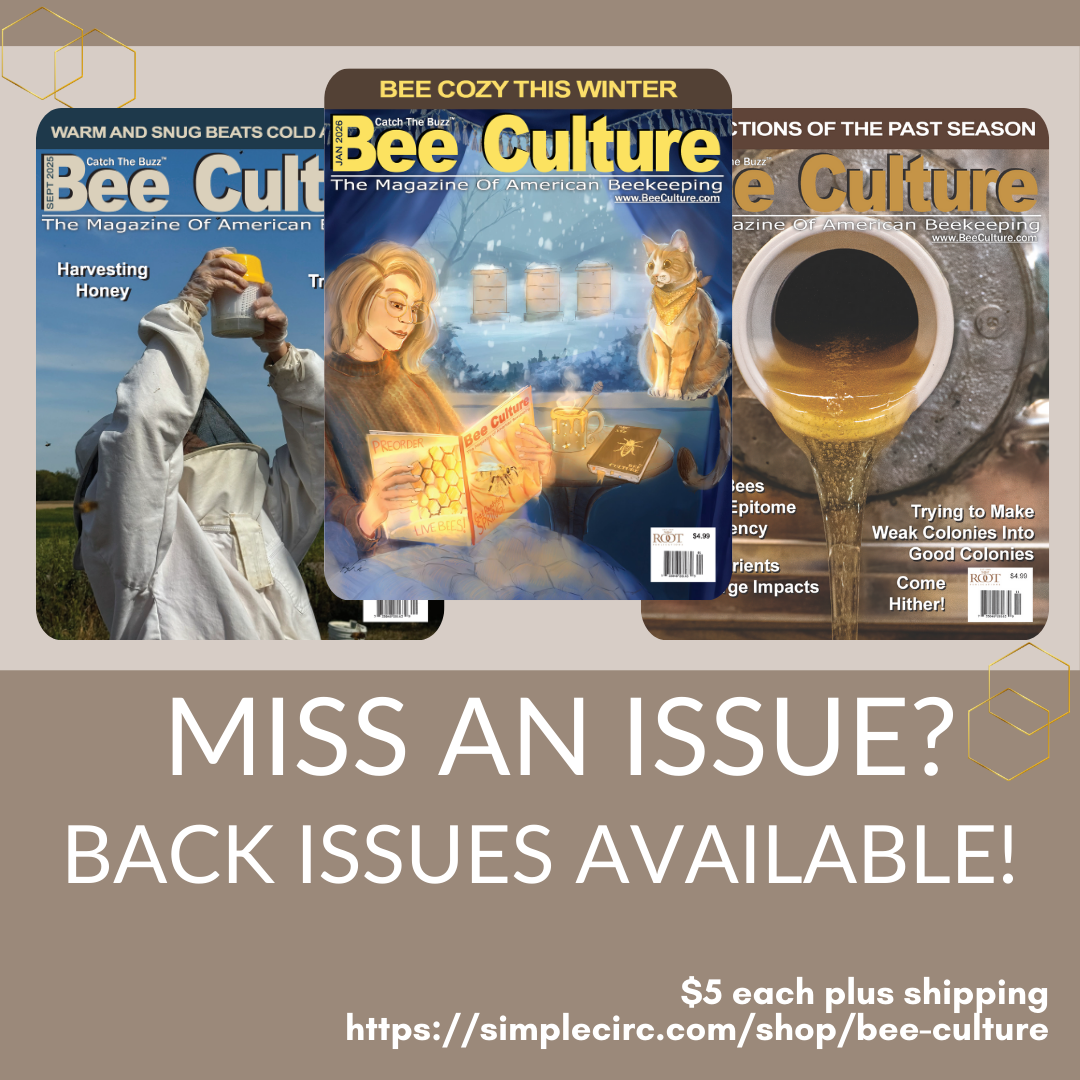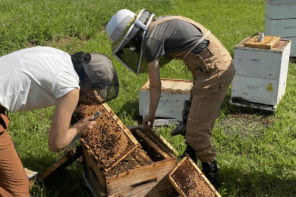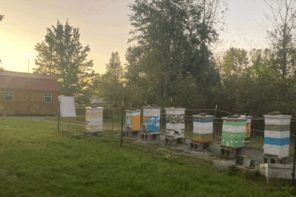By: Christy Hemenway
This article originally appeared in the Summer 2016 issue of BEEKeeping Your First Three Years
Well! Here it is, Spring again, the weather has warmed, there is bee food in bloom, and your most recent trip to the top bar hive(s) in your bee yard or back yard has you fairly hopping with excitement. The hive is thriving!
Congratulations on joining the growing ranks of top bar hive beekeepers who have successfully overwintered a top bar hive! Surviving Winter can be more of a challenge if you live in a cold climate
than if you live in a place that is perpetually warm and has bee forage all year round, but wherever you live, here you are now going into Year 2 with your top bar hive.
 So…what do you do now? What a great question to need the answer to!
So…what do you do now? What a great question to need the answer to!
If Spring has truly sprung in your bee yard, and there is early Spring forage available to your bees – your first step should be to reverse the steps you took to provide the hive’s Winter protection. If you built a windbreak, now you can dismantle it. If you wrapped the hive, unwrap it. If you insulated inside your roof, remove the insulation. If you installed a mouse guard – remove that as well. On a nice early Spring day, with appropriate temperatures, inspect your hive. Be sure to check their food stores, and look for early signs of swarming, such as the building of queen cups or cells along the edges of the combs.
Now let’s consider – what’s different between Year 1 and Year 2 in your top bar hive? In general there are 3 significant factors that figure into your second year management:
1. You’ve got Wax!
2 . There’s honey, Honey!
3. You’re about to have MORE BEES!
1 You’ve Got Wax. The most important difference and the most obvious – is that now, instead of an empty wooden box filled with blank top bars and a loose batch of bees hanging down from those bars in a tight cluster, you now have a box filled with drawn comb – and not just any old drawn comb, but natural wax combs built by your bees without the use of any artificially sized foundation.
All that beautiful natural wax means that your bees can change their focus – from start-up to build-up. Instead of devoting a lot of their energy to building their combs from scratch, the bees can concentrate on Spring brood rearing, and early season foraging.
The trickle down benefit of this one fact – drawn WAX comb – is widespread. It will help them expand the brood nest more quickly, and earlier in the season. This will soon mean a bigger field force, and that means more nectar and pollen being collected, which means HONEY, and … it will soon mean – MORE BEES!
2 There’s honey, Honey! As a general rule, the focus of top bar beekeepers is to support the bees’ natural systems going on inside the hive. So it’s very likely that a first year top bar hive went into the Winter with all, or certainly most, of the honey they were able to produce in their first season. It’s typical for a top bar beekeeper to harvest honey in the Spring, after the bees have survived the Winter on their own natural food. But now it IS Spring. There is bee forage everywhere, and more on the way as the season progresses.
Take into consideration what you know about the bloom season and the nectar flow in the area where your bees forage. Look around your bee yard or your backyard – what is available for your bees? Watch your bees – are they coming back to the hive with full pollen baskets? You may not know where they are gathering food from, but you can see the signs that there is food out there.
Some of the earliest sources of nectar and pollen include dandelions, maples, and willow. If those have begun blooming, the weather is warming, and your area is more or less past the danger of a late Spring frost, then you should take a look at what your bees have left in the way of honey stores, perhaps even with an eye toward having a bit of it for yourself – a sweet celebration – and the bees have a full season to make more, and to prepare for Winter once again.
There are two ways to enjoy this treasure of the hive. When your bees have made their own wax in a treatment-free top bar hive, that wax is free of the chemical contamination in wax foundation. This makes it a perfect candidate for a premium product: comb honey. To harvest honey as comb honey, simply remove it from the hive, gently shake and/or brush the bees from the comb, and cut the comb away from the top bar. Have on hand, hive-side, an appropriately sized container with a tight fitting lid, to prevent the bees from getting back to the comb. Take the comb inside, away from the bees, and lay it out on a flat surface such as a cookie sheet. Use a sharp knife to cut it to fit your choice of storage containers. If you have never had comb honey – I suggest you treat yourself to an extraordinary taste experience: Toast a piece of bread, then with a butter knife, spread a chunk of comb honey on that warm toast. Known as “bees on toast,” the light crunch of the warm toast and wax, along with the sweet honey is exquisite.
If you would like to harvest liquid honey – remove the comb from the hive in the same way, then crush-n-strain. Place the comb into a strainer. A 600 micron paint strainer from the hardware store is fine enough to remove wax and bees parts, but still leave the pollen, preserving the terroir of you r local honey, as well as its nutritional and medicinal benefits. Crush the comb to open the capped cells. Allow the honey to drain through the strainer. Bottle in a glass container of your choosing. Honey can crystallize over time, so be sure to avoid plastic containers; partly because of the taste they can impart to your honey, and partly because you want to be able to de-crystallize the honey by setting the jar into warm water in order to melt the crystals back into liquid. A plastic container may be damaged by heating.
3 You’re about to have MORE BEES! Your thriving hive now represents something very important to the bees themselves. If your hive did not make an attempt to swarm last year, you can be reasonably certain that they will this year – so it’s important that you be prepared to manage the bees’ swarm impulse.
Knowing that you’re about to have more bees, you can make some thoughtful and purposeful decisions. The first question to ask yourself is, do you actually want more bees? Do you have additional hive equipment; do you have enough space; do you have the time to care for more hives; do you really WANT more bees? If you do, then you should “manage for increase.” This means you do all you can to help your bees to reproduce at the colony level and to increase the size of your apiary.
If a larger apiary is not for you, consider doing one of two things:
• Do what you can to slow the swarm impulse, and possibly convince your bees that they aren’t so big and bad as they thought they were, and wouldn’t they really rather stay in the box and make lots of honey for you this year?
• Support the swarm impulse, and share those bees with another top bar hive beekeeper.
So…if you DO NOT want more bees, how do you slow the colony down, and convince them to stay home? The way to do this is to increase the amount of empty space in the brood area of the hive. We call it “opening the brood nest.” Increase the available space in the brood nest slightly – by inserting empty top bars into the “new” end of the brood nest. You want to do this somewhat judiciously, since the bees build each bar specifically to rest against its next-door neighbor, which you can see by the shape of each comb. Insert a blank bar between 2 bars of existing comb in the newer end of the brood nest, skip a few existing combs, insert another blank bar, skip a few more combs, then insert a third. This technique is disruptive to the purposeful building of the bees’ brood nest; so 3 is the maximum number of bars you should add at one time. One thing that drives the swarm impulse is the sense of becoming crowded. Opening the brood nest in this manner lessens their sense of being robust or feeling crowded.
Or … If you do not want more bees, but can provide thriving bees for another top bar beekeeper who does – we call this “paying it forward.” This is a good step in the direction of sustainability-and it also points out another important fact about hive equipment – that is, the need for hive parts that are interchangeable with other hives. For you to be able to split your hive and to pass the split along to another top bar beekeeper, your top bars must fit into the other beekeeper’s hive. That way the new beekeeper can trade you blank top bars for top bars with bees and comb on them, and everyone will still have the requisite number of top bars to fill their hive.
To split the hive, have on hand a “nuc box.” Any box that will safely hold 6-10 top bars while they are being transported to their new home will work, the best choice would look like a short version of a top bar hive. You will need to divide the hive’s resources – brood, especially open brood, and food – so that each hive has roughly equal amounts of each. If there are no swarm cells present in
the hive, this process is a simple division of brood and food – one bar for you, one bar for me – with the intent of moving 6-10 bars into the nuc box to form the new hive. This is typically referred to as a walk-away split – the beekeeper can simply walk away afterward – with no need to worry about the location of the queen. The hive that has no queen will make one from the open brood you
gave them, and the other hive has the existing queen.
If the hive has begun creating swarm cells, that makes this process a bit more complicated. You must decide whether you want to keep the existing queen, or pass her along to the new beekeeper. In either case, you want to be sure that the queen cells all wind up in one hive, and the queen in the other. You must know where the queen is for this split to be successful. The use of a queen catcher tool, designed to safely capture and hold the queen bee is very useful during this process.
Move the bees into the nuc box with as many bees on the comb as possible. The new hive will have fewer foragers because much of your field force is out foraging at the time this split is being performed, and so there will be a tremendous drop in the foraging population of the new hive. The more bees that make the move, the better, since the foragers currently in the field will all return home to the original hive.
The split procedure described here also works if you DO WANT more bees -you simply split them into a hive of your own.
Please note: At no point does it make sense to try to thwart the swarm impulse by simply destroying any queen cells that your bees make. This is just a sure-fire way of making your hive queenless, the exact opposite of having more bees!
The Summer build-up and Fall shut down of Year Two imitates Year One, except that there is already plenty of drawn comb. Then … all too soon, you will find yourself preparing for another successful Winter. But you already know how to do that – you’ve succeeded once already!
Congratulations!










